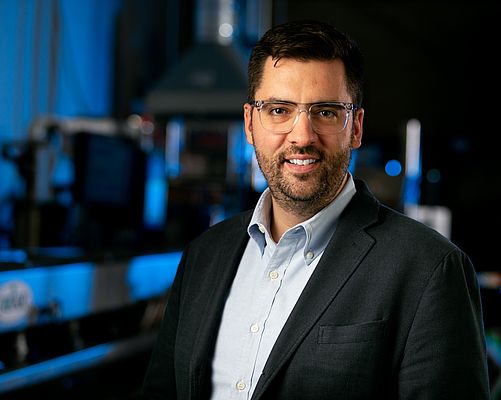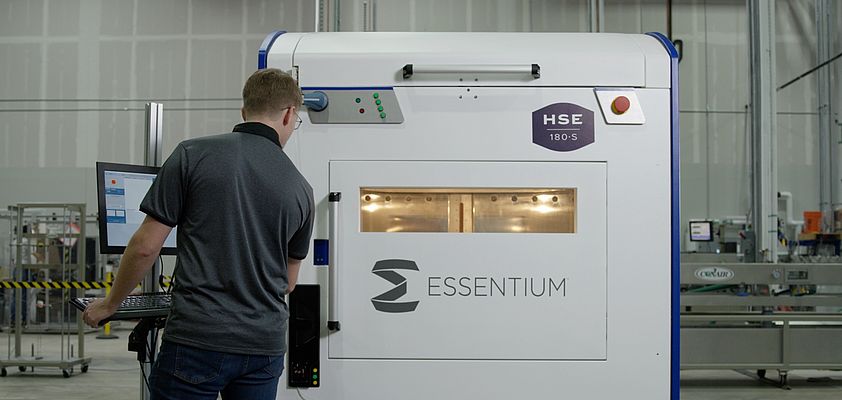IEN Europe: Can you tell us more about Essentium and its mission?
B. Teipel: We are focused on transforming the future of factory floors by accelerating the potential of industrial-scale Additive Manufacturing (AM). As innovators in both materials and production platforms, our vision is to transform traditional manufacturing processes by bringing strength and speed together, at scale, with a no-compromise material set. By developing an entire system, our goal is to reinvent the financial aspect of industrial 3D printing to make it more accessible to a wider range of manufacturers. We are committed to advancing AM capabilities and creating a global, open ecosystem that puts customers in control of their innovation.
In the past, AM has been seen as a prototype, one-off, custom, jig or fixturing solution, not a production solution. That creates a gap between innovation and scale that clearly needs to be filled for AM to fulfil its huge potential. The Essentium High Speed Extrusion (HSETM) 3D Printing Platform enables the ability to scale by delivering speed, or time to part and by delivering value, or better cost per part.
IEN Europe: What’s the status of additive manufacturing today? Do you think it will be possible to scale it up?
B. Teipel: Recent research commissioned by Essentium exploring the attitudes of AM stakeholders clearly shows that AM at scale is now a reality, giving companies new ways to become more competitive on a global scale.
The survey found a significant increase in the use of large-scale AM. The number of manufacturers using 3D printing for full-scale production has doubled compared to the previous year (40% in 2019; 21% in 2018). It also revealed that two-thirds of companies have more than doubled their use of industrial-scale AM in their manufacturing, and 47% are now using the technology for runs of thousands of printed parts, a jump of 17% compared to 2018.
IEN Europe: Why 3D printing is an added value for today’s manufacturers?
B. Teipel: With the latest 3D printing platform innovations including hardware, software and materials coming together, companies will be able to manufacture in new ways to improve agility, reduce complexity, and lower operational costs.
In addition, AM at scale will help them overcome key hurdles including:
- Responding quickly to demand spikes: Whether they are making consumer electronics or basketball shoes, manufacturers never know when a huge spike in demand will suddenly hit. And with traditional manufacturing methods, it’s very hard to quickly capitalize on that opportunity.
- Supply chain disruption: Another significant benefit of AM will be the ability to produce components closer to home rather than relying on imports. It will not only cut costs, but it will help firms at times of global issues such as the Coronavirus which has seen China factories suspending operations.
- Creating complex designs: For example, to produce lightweight components that are critical in aerospace and defense (A&D) and automotive industries.
- Talent shortages: There is currently a global shortage of programmers who can operate CNC machines. And, even when they can be found, skilled CNC programmers are expensive to hire. This makes it difficult for small manufacturers to compete with larger rivals.
- Delivering greater customization: Consumers increasingly want custom-made products that match their personal lifestyles. The elimination of tooling that comes with additive manufacturing also means that companies can produce more customized parts faster and at lower costs.
IEN Europe: What are the limits of this technology?
B. Teipel: In a recent study commissioned by Essentium, 91% of manufacturing executives viewed 3D printing as strategically important in the next five years, but 51% indicated that the high cost of materials is hindering adoption of large-scale 3D printing, while 38% believe current 3D printing hardware is too expensive. So, you've got an expensive solution on the floor, and then an expensive ongoing commitment from a closed materials strategy. To address those issues, Essentium is committed to driving down costs to allow our users to rely on this technology, and design for this technology in ways that we think will be transformative.
IEN Europe: What’s the objective of creating an open extrusion additive ecosystem? How are you working with BASF and Materialise for that?
B. Teipel: The majority of 3D printer vendors adopt a closed system whereby customers are locked into using the vendors’ hardware, processes and materials. Essentium’s research shows that this strategy isn’t working for manufacturers. While 85% of manufacturers reported that industrial-scale AM has the potential to increase revenue for their business; 22% said their 3D printing efforts have resulted in vendor lock-in that limits flexibility. In order to be competitive, large production manufacturers are demanding open materials for differentiation, cost and scale, in fact, virtually all (99%) executives surveyed believe an open ecosystem is important to advance 3D printing at scale.
Essentium is collaborating with partners including multinational chemical company BASF and 3D software developer Materialise NV in an open ecosystem, to advance 3D printing platforms that can use open materials to give manufacturers greater control of their innovation, more choice in materials, and industrial-scale production at ground-breaking economics.
IEN Europe: What advantages do the materials that you introduced in November 2019 bring?
B. Teipel: Material constraints are one of the biggest barriers to turning 3D printing into full-scale production runs for manufacturers worldwide. Essentium’s open extrusive additive ecosystem is giving customers more control, greater choice in materials and ultimately lower cost and higher volumes.
Essentium developed the new High-Temperature (HT) nylon range of materials to offer manufacturers a cost-effective alternative to niche HT materials. Combining nylon with carbon fibre, the materials are more than four times stronger than high-performance Acrylonitrile Butadiene Styrene (ABS) and have a heat deflection temperature of 200°C, allowing manufacturers to print tough and impact resistant parts to withstand the rigours of the factory floor.
Sara Ibrahim


















